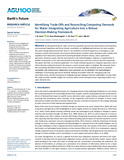JavaScript is disabled for your browser. Some features of this site may not work without it.
| dc.contributor.author | Knox, Jerry W. | |
| dc.contributor.author | Haro Monteagudo, David | |
| dc.contributor.author | Hess, Tim M. | |
| dc.contributor.author | Morris, Joe | |
| dc.date.accessioned | 2018-04-12T14:34:39Z | |
| dc.date.available | 2018-04-12T14:34:39Z | |
| dc.date.issued | 2018-02-26 | |
| dc.identifier.citation | Knox JW, Haro‐Monteagudo D, Hess TM, Morris J. (2018) Identifying trade-offs and reconciling competing demands for water - integrating agriculture into a robust decision-making framework. Earth's Future, Volume 6, Issue 10, October 2018, pp. 1457-1470 | en_UK |
| dc.identifier.issn | 2328-4277 | |
| dc.identifier.uri | https://doi.org/10.1002/2017EF000741 | |
| dc.identifier.uri | http://dspace.lib.cranfield.ac.uk/handle/1826/13137 | |
| dc.description.abstract | Increasing demands for water, driven by population growth and socio‐economic development, environmental regulations and future climate uncertainty, are highlighting limitations on water supplies. This water‐energy‐food‐environment nexus is not confined to semi‐arid regions but is emerging as a key business, societal and economic risk in humid and temperate countries, where abundant water supplies and regulation have historically coped with fluctuating demands between industry, power generation, agriculture, domestic supply and the environment. In the UK, irrigation is supplemental to rainfall, consumptive in use and concentrated in the driest years and most resource‐stressed catchments. This paper describes an empirical application of a mixed methods approach to integrate agriculture into a robust decision‐making framework, focusing on a water‐stressed region in England. The approach shows that competing demands between sectors can be reconciled and that potential options or portfolios compatible with multi‐sectoral collaboration and investment can be identified. By combining model outputs to forecast the impacts of climate and socio‐economic change on agricultural demand within a regional water resource simulator, future spatial estimates of demand were derived. A set of search and tracked metrics were used to drive multi‐criteria searches to identify preferred supply and demand management orientated portfolios. The methodological challenges in forecasting agricultural demand, defining acceptable ‘trade‐offs’, managing scale and uncertainty issues and the importance of engendering open dialogue between stakeholders is described. The study provides valuable insights for countries where similar emergent issues regarding conflicts over water demand exist. | en_UK |
| dc.language.iso | en | en_UK |
| dc.publisher | Wiley | en_UK |
| dc.rights | Attribution-NonCommercial-NoDerivatives 4.0 International | * |
| dc.rights.uri | http://creativecommons.org/licenses/by-nc-nd/4.0/ | * |
| dc.subject | agriculture | en_UK |
| dc.subject | climate change | en_UK |
| dc.subject | modelling | en_UK |
| dc.subject | water resources | en_UK |
| dc.subject | risk; uncertainty | en_UK |
| dc.title | Identifying trade-offs and reconciling competing demands for water - integrating agriculture into a robust decision-making framework | en_UK |
| dc.type | Article | en_UK |
| dc.identifier.cris | 19958987 |
Files in this item
The following license files are associated with this item:
This item appears in the following Collection(s)
-
Staff publications (SWEE) [2825]

